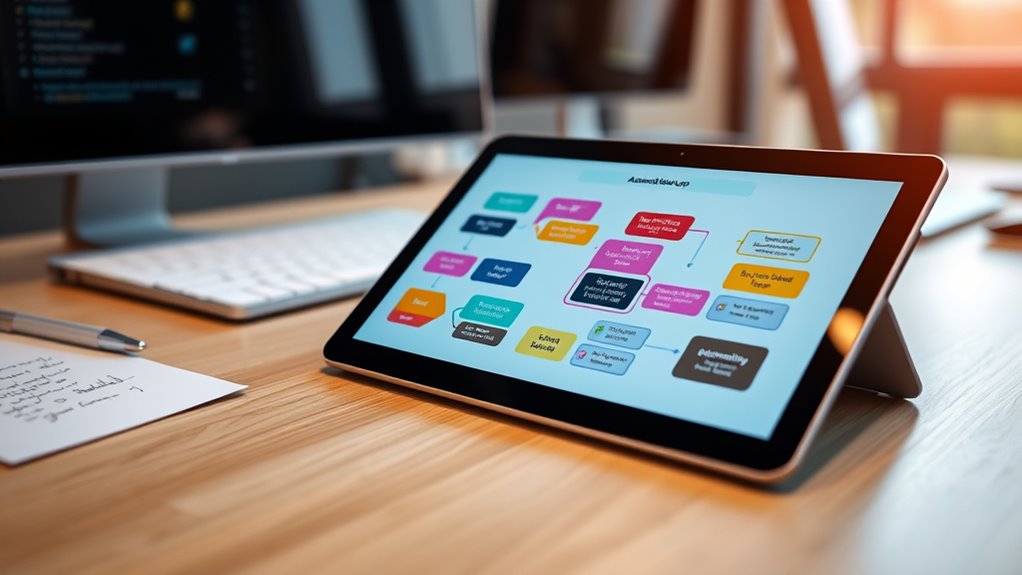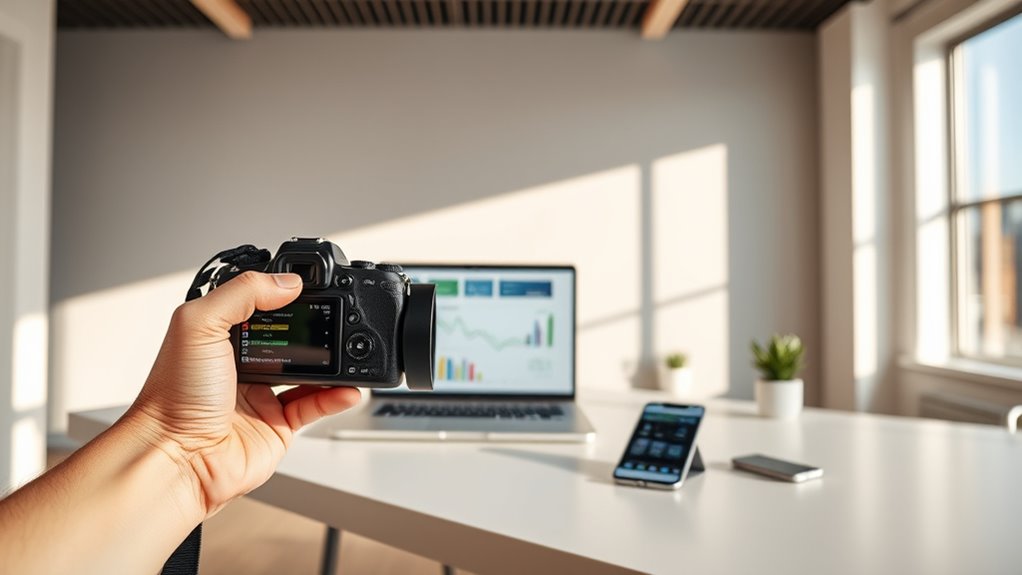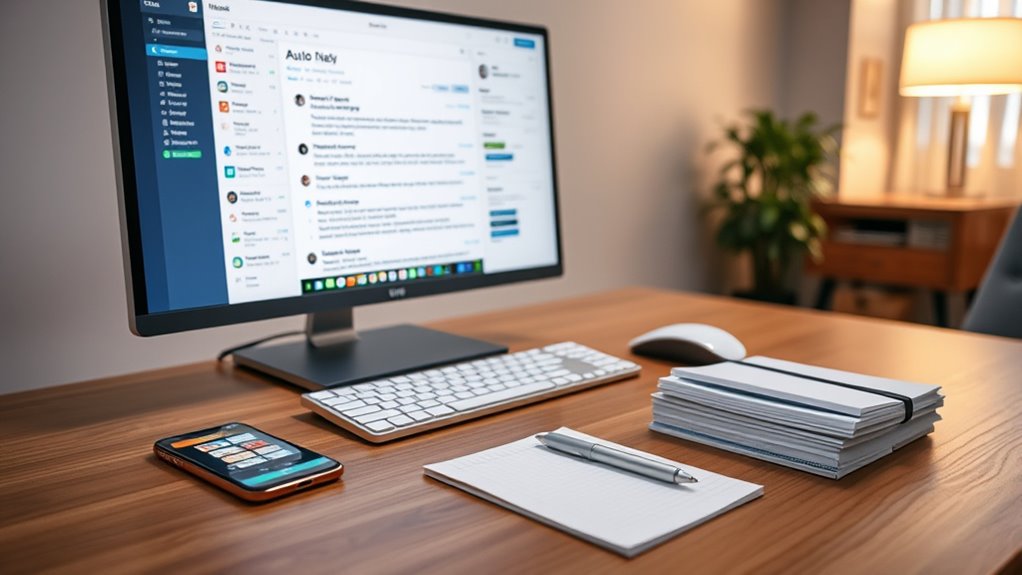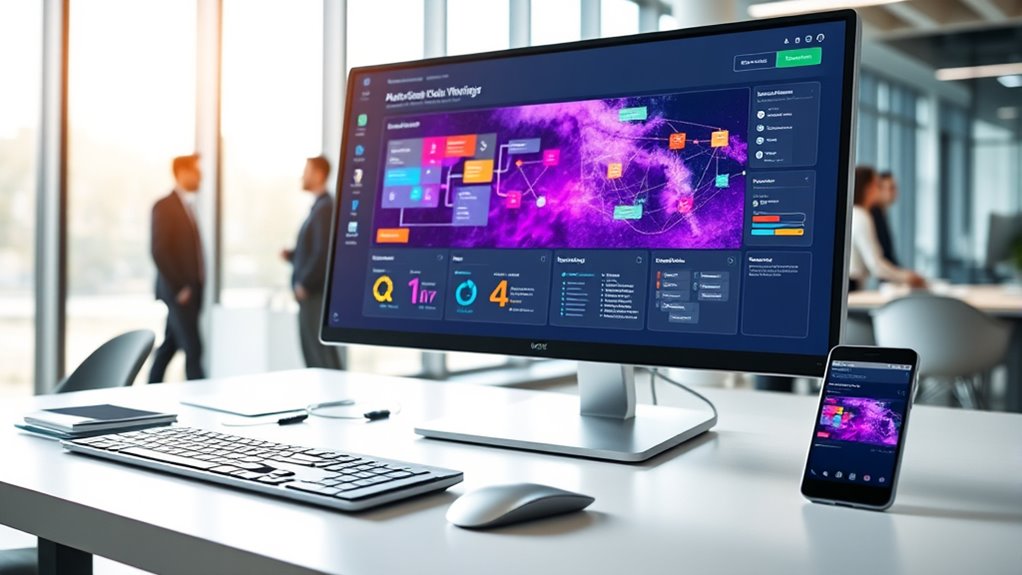Automating follow-ups helps you stay engaged with prospects and clients effortlessly. By using the right tools, you can send personalized messages based on triggers like actions or time intervals. Craft messages that resonate, and then set up workflows to deliver these at ideal moments. Monitor results and adjust your sequences to keep your communication natural and effective. Keep exploring to uncover how fine-tuning these strategies can boost your results even further.
Key Takeaways
- Choose a platform with customizable templates and CRM integration for seamless automation.
- Define clear trigger conditions based on user actions to initiate follow-ups automatically.
- Personalize messages using segmentation and dynamic content for better engagement.
- Test workflows thoroughly and monitor engagement metrics to optimize performance.
- Maintain a personal touch by incorporating genuine empathy and tailored content into automated messages.
Understanding the Importance of Follow-Up Automation

Follow-up automation is essential because it guarantees you stay engaged with prospects and clients without constant manual effort. When you automate your follow-ups, you improve lead nurturing by sending timely, personalized messages that guide prospects through the sales funnel. This consistent communication helps build trust and keeps your brand top of mind. Additionally, follow-up automation plays a critical role in customer retention, as it ensures you stay connected after a purchase, addressing concerns and offering support. By automating these interactions, you save time and reduce the risk of neglecting important touchpoints. Overall, integrating follow-up automation strengthens relationships, boosts conversion rates, and creates a seamless experience that encourages long-term loyalty. Incorporating customer engagement strategies into your automation can further enhance your connection with clients.
Choosing the Right Tools for Automated Follow-Ups

Selecting the right tools for automated follow-ups is crucial to guarantee your outreach is efficient and effective. Look for platforms that offer customizable email templates, so you can personalize messages without starting from scratch. These templates help maintain consistency and save time. Additionally, consider integration options with your existing CRM or marketing tools—seamless integration ensures smooth data flow and better campaign management. A good tool should also let you automate follow-up scheduling based on triggers or recipient actions. Evaluate the user interface for ease of use, and check if the platform provides analytics to track your follow-up performance. Incorporating security vulnerabilities awareness into your choice ensures your processes remain protected against potential threats. Choosing a tool with these features ensures your automated follow-ups are streamlined, personalized, and aligned with your overall outreach strategy.
Crafting Effective Follow-Up Messages

To make your follow-up messages stand out, focus on personalization strategies that resonate with your audience. Timing and frequency also matter—sending messages at the right moments keeps engagement high without overwhelming your contacts. Finally, include a clear call-to-action that guides recipients toward the next step effortlessly. Incorporating elements of personal growth can further enhance your communication effectiveness.
Personalization Strategies for Engagement
Personalization is key to capturing your audience’s attention and encouraging meaningful engagement. To do this effectively, focus on implementing personalization tactics that resonate with each recipient. Start by utilizing audience segmentation to group contacts based on their interests, behaviors, or demographics. This allows you to craft follow-up messages that feel relevant and personalized rather than generic. Use dynamic content to tailor the message’s tone, offers, or information to match each segment’s preferences. Personalization tactics like referencing previous interactions or including personalized recommendations boost engagement and build trust. Remember, the more targeted your follow-ups are, the higher the chances of sparking meaningful responses and fostering long-term relationships. Personalization isn’t just a nice touch — it’s essential for effective follow-up messaging.
Timing and Frequency Tips
Timing and frequency are vital to maximizing the impact of your follow-up messages. A solid timing strategy helps guarantee your messages arrive when your audience is most receptive, increasing engagement. Avoid sending follow-ups too soon, which might seem pushy, or too late, which could cause missed opportunities. Instead, space your messages thoughtfully based on your recipient’s behavior and preferences. Frequency planning also plays a key role; sending too many messages can overwhelm and annoy, while too few may reduce your chances of a response. Find a balanced rhythm that keeps you top-of-mind without becoming intrusive. Test different intervals and monitor responses to refine your timing approach, ensuring each follow-up remains relevant and effective. Additionally, understanding anime culture and storytelling can help tailor your messages to better resonate with your audience.
Clear Call-to-Action Techniques
Effective follow-up messages clearly state what action you want your recipient to take next. A strong call-to-action (CTA) guides them seamlessly toward that step. To guarantee message clarity, keep your CTA specific and straightforward—avoid vague phrases like “follow up soon.” Instead, use precise language such as “schedule a call” or “review the attached document.” Place your CTA prominently, preferably near the end of your message, so it stands out. Use active voice to make your instructions direct and compelling. Keep your tone polite yet assertive, making it easy for your recipient to understand exactly what you expect. Clear call-to-action techniques eliminate confusion, increase engagement, and help you achieve your follow-up goals efficiently. Additionally, avoiding passive voice in your instructions ensures your message remains clear and direct.
Setting Up Automated Workflows and Triggers

To set up automated workflows, you need to define what will trigger them. You can customize these trigger conditions to match specific actions or timeframes. Once everything is in place, testing your sequences guarantees they run smoothly and achieve your follow-up goals. Incorporating user experience (UX) optimization ensures that your automated processes align with overall site performance and engagement metrics.
Defining Workflow Triggers
Setting up automated workflows begins with defining triggers that initiate specific actions based on user behavior or system events. You need to identify trigger conditions that determine when a workflow starts. These conditions could include actions like a user signing up, clicking a link, or reaching a certain score. Your trigger conditions should align with your goals and help ensure the workflow logic flows smoothly. When setting triggers, consider how precise they need to be—more specific triggers reduce false starts, while broader ones catch more scenarios. Clear trigger definitions are essential for reliable automation. As you establish these, focus on creating straightforward, measurable conditions that activate workflows at the right moments, ensuring your follow-up process is timely and effective. Additionally, understanding trigger conditions in aquatic exercise can help tailor your automation to better engage users interested in water-based fitness options.
Customizing Trigger Conditions
Customizing trigger conditions allows you to tailor your workflows to respond precisely to specific user actions or system states. With trigger customization, you can set up condition filtering to ensure your automation activates only when certain criteria are met. For example, you might trigger follow-ups only when a user opens an email, clicks a link, or reaches a particular stage in the sales process. By refining these conditions, you avoid unnecessary actions and make your workflows more efficient. Condition filtering helps you create targeted, relevant follow-ups that resonate with your audience. Remember, the more specific your trigger conditions, the better you can personalize your automated sequences and improve overall engagement. Additionally, understanding how fan trailers serve as a storytelling playground can inspire creative ways to design engaging automated workflows.
Testing Automated Sequences
After defining your trigger conditions, it’s important to verify that your automated workflows function as intended. Testing ensures your emails reach the right audience and that content variations are effective. You should review how your sequences perform across different segments, checking if email segmentation targets the right groups. Make sure your triggers activate at the correct times and that follow-ups send as planned. Testing also involves reviewing content variations to see which messages resonate best. Consider sending test emails to yourself or colleagues to catch any issues before launching. Additionally, monitor engagement metrics during testing to identify areas for improvement. By thoroughly testing, you guarantee your automated follow-ups deliver personalized, timely messages that improve engagement and conversions. Ensuring your content aligns with audience preferences can enhance overall effectiveness and response rates.
Monitoring and Adjusting Your Follow-Up Sequences

Monitoring and adjusting your follow-up sequences is essential to guarantee they remain effective and relevant. You should regularly review how different customer segments respond, tailoring your approach based on their behavior and preferences. Keep an eye on message frequency to prevent overwhelming or under-engaging your audience. If certain segments show signs of disengagement, consider spacing out messages or personalizing content further. Conversely, if others respond positively to more frequent touches, modify your sequence accordingly. Use analytics to track open rates, click-throughs, and conversions, then refine your sequence based on these insights. This ongoing process ensures your follow-ups stay targeted, timely, and valuable, ultimately increasing engagement and driving better results. Incorporating mindfulness techniques such as deep breathing exercises can help maintain a clear focus during this process, reducing stress and promoting thoughtful adjustments.
Best Practices for Maintaining a Personal Touch

Maintaining a personal touch in your follow-up communications is essential for building trust and fostering genuine connections. When you incorporate creative personalization, you show your audience that you care about their individual needs, making your messages more impactful. To strengthen emotional connection, tailor your messages to reflect shared interests or past conversations. Use their names, reference specific details, and keep your tone warm and authentic.
- Use personalized content based on previous interactions
- Share stories or insights relevant to their situation
- Handwrite a quick note or add a personal touch digitally
- Show genuine empathy and understanding in your responses
Frequently Asked Questions
How Can I Personalize Automated Follow-Ups at Scale?
To personalize automated follow-ups at scale, you should focus on effective segmentation techniques and personalization strategies. Segment your audience based on behaviors, preferences, or demographics, then tailor your messages accordingly. Use dynamic content and personalized greetings to make each follow-up feel unique. This approach guarantees your messages resonate more deeply, increasing engagement and conversions, while saving you time and effort in managing large-scale outreach efforts.
What Are Common Mistakes to Avoid in Automation?
When automating follow-ups, you should watch out for common mistakes like scheduling errors that send messages at the wrong times, and overautomation pitfalls that make interactions feel impersonal. You might be tempted to set everything on autopilot, but this can backfire. To avoid these issues, always review your automation workflows regularly, personalize where possible, and guarantee timing aligns with your audience’s needs. Staying attentive helps keep your automation effective and genuine.
How Do I Handle Responses From Automated Follow-Ups?
They say “forewarned is forearmed,” so handling responses starts with effective response tracking. When you get responses, review them promptly, and apply escalation protocols if needed. Use automation tools to flag urgent replies and keep communication timely. Staying organized ensures you don’t miss important messages, and adapting your approach based on responses helps build stronger relationships. Always remember, quick, thoughtful follow-up makes all the difference.
Which Industries Benefit Most From Follow-Up Automation?
You’ll find that industries like retail, real estate, and SaaS benefit most from follow-up automation. These sectors thrive on sales innovation and customer outreach, making timely, personalized follow-ups essential. Automation helps you stay engaged with prospects, nurture leads, and increase conversions. By streamlining your follow-up process, you can focus on building relationships and closing deals more efficiently, giving you a competitive edge in today’s fast-paced market.
How Can I Integrate Automated Follow-Ups With CRM Systems?
Did you know that integrating automated follow-ups can boost customer engagement by 30%? To do this, you should connect your CRM with your email system using email triggers. Confirm data synchronization so all customer info stays updated across platforms. This way, your follow-ups are timely and personalized, saving you time while maintaining strong relationships. Start by exploring CRM plugins or APIs that support seamless integration.
Conclusion
By automating your follow-ups, you can boost your engagement by up to 80%, saving time while maintaining consistency. Remember, the key is to balance automation with a personal touch to keep your audience genuinely connected. Regularly monitor your sequences and make adjustments to stay relevant. When done right, automated follow-ups not only streamline your process but also strengthen relationships, ultimately driving better results and growth for your business.









